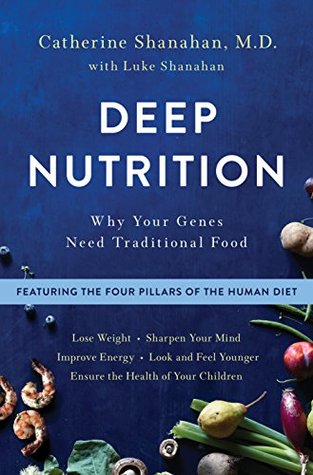More on this book
Community
Kindle Notes & Highlights
Epigenetic researchers study how our own genes react to our behavior, and they’ve found that just about everything we eat, think, breathe, or do can, directly or indirectly, trickle down to touch the gene and affect its performance in some way.
The concept of gene health is simple: genes work fine until disturbed. External forces that disturb the normal ebb and flow of genetic function can be broken into two broad categories: toxins and nutrient imbalances.
most powerful class of gene-regulating factors: food.
We get sick because our genes didn’t get what they were expecting, one too many times.
By simply replenishing your body with the nourishment that facilitates optimal gene expression, it’s possible to eliminate genetic malfunction and, with it, pretty much all known disease.
The health of your genes represents a kind of inheritance. Two ways of thinking about this inheritance, genetic wealth and genetic momentum, help explain why some people can abuse this inheritance and, for a time, get away with it.
Those deleterious genetic alterations mean that her child will have lost genetic momentum and will not have the same potential for health or beauty as she did.
Such squandering of genetic wealth—a measure of the intactness of epigenetic programming—has affected many of us.
Thanks to the plasticity of genetic response we can all improve the health of our genes and rebuild our genetic wealth.
1. Meat cooked on the bone 2. Organs and offal (what Bourdain calls “the nasty bits”) 3. Fresh (raw) plant and animal products 4. Fermented and sprouted foods—better than fresh!
Almost nothing gives a woman more pride and confidence than the birth of her first child. After one successful pregnancy, there is an understandable expectation that a second pregnancy will go even more smoothly. And perhaps it will, at least for mom; more distensible pelvic tissues do facilitate an easier second labor.122 But unless the mother gives herself ample time (generally at least three years) and nutrients for her body to fully replenish itself, child number two may not be as healthy as his older sibling.
This marvelous nutrient-scavenging ability of a human placenta means that even in conditions of insufficient maternal nutrition the first child may come out relatively intact. Meanwhile, mom’s body may be depleted to the point that before and after pictures reveal her spine to have curved, her lips thinned, and she may have trouble remembering and learning new things, or feel anxious and depressed—as in postpartum depression.
However, any child conceived in too short a time for those storehouses to be refilled will be at significant disadvantage. In such depleted conditions, were baby to extract from mother all the nutrients its genes would like it to have, this would put mom’s life at significant risk.
Not only does sugar and vegetable oil consumption disrupt maternal metabolism and lead to gestational diabetes, pre-eclampsia, and other complications of pregnancy, the sugar and vegetable oils streaming through a developing baby’s blood block signals in the womb, disrupting the sequence of highly sensitive, interdependent developmental events that contribute to the miracle of a healthy birth.129, 130
Previous studies have shown that births less than eighteen months apart increase child mortality and, in some cases, stunt growth.
As we’ll see in later chapters, two foods that most powerfully promote oxidative stress are vegetable oils and sugar. In other words, too much vegetable oil and sugar in mom’s diet create chemical interference, delaying signal transmission between mom’s body and her own uterus. This type of symmetry shift is most pronounced in the first pregnancy due to the fact that, by the second pregnancy, the uterus has been prepped by the first, which is why the second delivery typically goes faster.
But it soon became clear that their more immediate goal, by virtue of the realities of economics, was the acquisition of grant funds, necessitating a never-ending sequence of compromises between the exigencies of financing and the integrity of the science.
It showed that one in three pregnant women consuming what mainstream research suggests would be a healthy diet nevertheless gave birth to babies with dangerously low levels of vitamin A in their blood.
But supplementing with cod
liver oil during pregnancy has protective and lasting effects on the baby’s intelligence.
While the prenatal pill partially addresses the issue of nutrient deficiency, it does nothing to address the overconsumption of sugar and vegetable oil, both of which interfere with signal transmission required for normal growth and development.
the prenatal vitamin pill works best when taken before conception because it helps to boost a woman’s vitamin levels to prepare for the first ten weeks of pregnancy, the time when the most fundamental decisions about how to shape the baby’s body are made. After that window of opportunity has shut, though it can still improve birth weight, the vitamin pill can do little to prevent most major birth defects.
We all gain from children’s good health, which requires giving mom’s body at least three—preferably four—years to refortify her tissues with a generous supply of nutrients.
Ideally, you will give yourself at least three months prior to conception to detox and refortify your system but I would recommend six to twelve months if you are prediabetic or overweight because both these conditions can involve profound metabolic and hormonal dysfunction and imbalance.
Your lipoprotein particle size is the best gauge of your risk of heart attack.
free radical cascades make your arteries extremely crispy. They will also damage other bodily tissues, which can generate inflammation, a kind of chemical chaos that interferes with normal metabolic function.
HOW I INTERPRET A STANDARD LIPID PANEL
Primal Kitchen’s new mayo product,
SUGAR’S PSEUDONYMS
Meat on the bone Fermented and sprouted foods Organs and other “nasty bits” Fresh, unadulterated plant and animal products


